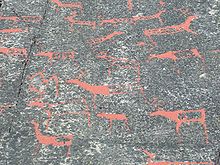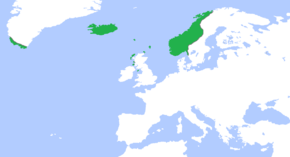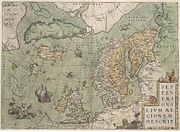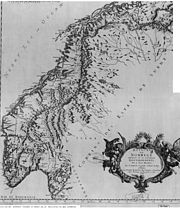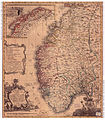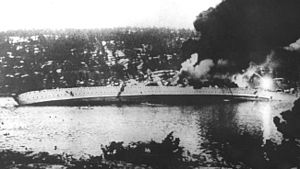- History of Norway
-
"Stattholder" redirects here. For the office in the Low Countries, see Stadtholder.
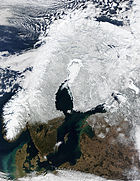
This article is part of a series on Scandinavia Geography Viking Age - Old Norse
- Viking
- Thing (assembly)
- Mythology
- Christianization
- Northern Arc
Political entities History of Scandinavia Other - Languages
- Scandinavism
- Nordic Council
- Monetary Union
- Defence Union
- Scandinavian Airlines
The history of human settlement in what is present day Norway goes back at least 11,000 years, to the late Paleolithic. Archaeological finds in the county of Møre og Romsdal have been dated to 9,200 BC and are probably the remains of settlers from Doggerland, an area now submerged in the North Sea, but at the time a landbridge that connected the present day British Isles with Jutland. The Fosna-Hensbacka culture inhabited parts of Norway about 8300 BC to 7300 BC. Petroglyphs dating from the Neolithic Age (in Norway 4000 BC to 1800 BC) show scenes of hunter-gatherers. More permanent settlements developed during the Bronze Age (1800 BC to 400 BC) and Iron Age. The earliest runes (an inscription in North Germanic) that have been found were inscribed on an arrowhead dating from about 200 AD. Many more inscriptions appear until 800 AD; a number of small kingdoms developed during these centuries.
The period from 800–1066 saw significant expansion, and is referred to as the Viking age. During this period, Norwegians, as well as Swedes and Danes, traveled abroad on longships, as raiders, explorers, settlers and traders. By the middle of the 11th century, the Norwegian kingdom was firmly established, although there was still only a very rudimentary administrative framework. The Black Death arrived in Norway in 1349, killing perhaps half the population, after which Norway entered into a period of decline.
Between 1396 and 1536 Norway was a part of the Kalmar Union, and from 1536 to 1814 Norway was effectually a tributary to Denmark, named as the personal union Denmark–Norway. Denmark–Norway entered into an alliance with Napoleon, with the war leading to dire conditions and mass starvation in 1812. In 1814 Denmark–Norway was defeated in the Napoleonic wars and the king was forced to cede Norway to the king of Sweden in the Treaty of Kiel (January 14). Sweden and Norway adopted a loose union, in which Norway was permitted to maintain its own Constitution.
This period also saw the rise of the Norwegian romantic nationalism cultural movement, as Norwegians sought to define and express a distinct national character. The union with Sweden was dissolved in 1905. Norway remained neutral during World War I. Norway claimed neutrality again during World War II, but was occupied by German forces from April 9, 1940 until May 8, 1945.
Norway joined NATO in 1949 and in 1960 the European Free Trade Area (one of seven states).[1] Two plebiscites to join the European Union failed by narrow margins in 1972 and 1994. Norway has been a close ally of the United States. Large reserves of petroleum and natural gas were discovered in the 1960s, which led to a continuing boom in the economy. Whaling was once an important industry and commercial fishing continues to be so.
Etymology
Modern etymologists believe the country's name means "the northward route" (the way north or the north way), which in Old Norse would be nor veg or *norð vegr. The Old Norse name for Norway was Nóregr, in Anglo-Saxon Norþ weg, and in mediaeval Latin Northvegia. The present name of the Kingdom of Norway in Norwegian Bokmål is "Kongeriket Norge" and in Norwegian Nynorsk "Kongeriket Noreg", both only a couple of letters removed from the original "northern way"; "Nor(d)-(v)e.g.
Pre-historic age (10,000 BC–800 AD)
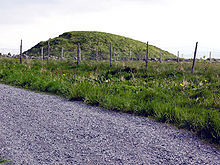 Burial mound on Karmøy
Burial mound on Karmøy Main article: Nordic Stone AgeMain article: Nordic Bronze AgeMain article: Pre-Roman Iron AgeMain article: Roman Iron AgeMain articles: Germanic Iron Age and Migration Period
Main article: Nordic Stone AgeMain article: Nordic Bronze AgeMain article: Pre-Roman Iron AgeMain article: Roman Iron AgeMain articles: Germanic Iron Age and Migration PeriodSettled since the end of the last ice age, modern-day Scandinavia contains finds from the Stone age and Bronze age, such as rock carvings.
Pytheas description of Thule as a land six days sailing north of Britain, where there is no nightfall in summer, might be the first written reference to what we today know as Norway. Later Scandinavia is known for its Iron Age culture. From around the time of the Roman Empire until about 800 AD, many stone inscriptions can be found, written in Runes. Apparently, the petty kingdoms developed during these centuries.
See also: Komsa, Fosna-Hensbacka culture, Funnelbeaker culture, Hamburg culture, Nøstvet and Lihult cultures, and Maglemosian cultureThe Viking Age (800–1066)
See also: Viking Age and Unification of Norway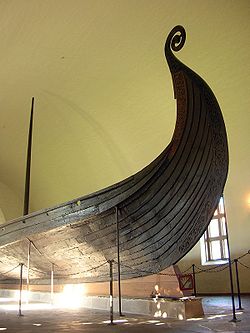 The Oseberg Viking Ship which is exhibited in the Viking Ship Museum in Oslo
The Oseberg Viking Ship which is exhibited in the Viking Ship Museum in Oslo
The period from 800–1066 AD is referred to in Norwegian history as the Viking age. During this period, Norwegians, as well as Swedes and Danes, traveled abroad on longships, as raiders, explorers, settlers and traders. Viking raids affected large parts of Europe. The Norwegian Vikings mainly traveled west, to Britain and Ireland. Emigrants from Norway colonized Shetland, Orkney, the Faroe Islands and Iceland. From Iceland, Greenland was also colonized, and voyages were even made to North America, where remains of Viking dwellings have been found in Newfoundland.
Several historic works, known as the kings' sagas were written in Norway and Iceland in the 12th and 13th centuries, the best known of which is Snorri Sturluson's Heimskringla (c. 1220). These provide our main sources for the early history of Norway. However, their accuracy for the earliest period is uncertain, and a much debated topic among modern historians. The stories about the earliest times are partly legendary in nature, and can hardly be taken as accurate history.
The period of the Viking age coincides with the first consolidation of a single Norwegian kingdom. By the time of the first historical records of these events, about the 700s AD, Norway was divided into several petty kingdoms. It is also assumed that Danish rulers often held sway in the Oslofjord-area.
King Harald Fairhair is the king who is credited by later tradition as having unified Norway into one kingdom. According to the sagas, he ruled Norway from approximately 872 to 930. Modern historians assume that his rule was limited to the coastal areas of southern Norway. Kings of Norway until King Olav IV, who died in 1387, claimed descent from Harald Fairhair. After Harald's death, the unity of the kingdom was not preserved, and for the next century, the kingdom was variously ruled, wholly or in part, by descendants of King Harald or by earls under the suzerainty of Denmark.
During this period, Christianity was introduced to Norway, probably mainly from the British Isles. In terms of church organization, Norway remained part of the Archdiocese of Bremen until 1152 or 1153. The first Norwegian king to have adopted Christianity was, according to the sagas, Harald Fairhair's son, King Haakon the Good (c. 934–961). Haakon did not force his subjects to accept the new religion. His successors, Olaf Tryggvason (c. 995–1000), and Olaf Haraldsson (St. Olav) (1015–1028) resorted to forceful means to convert the Norwegian people. Olaf Haraldsson was probably the first King of Norway to extend his rule to the inland regions of eastern Norway, and to have ruled more or less the whole of the present-day country. His death in the battle of Stiklestad in 1030 is traditionally considered a milestone in the history of the Christianisation of the country, although religion was not one of the issues at stake in that battle. After his death, Olaf was revered as a saint. He became the patron saint of Norway, and by the end of the century, Christianity was the only religion allowed in the country. In theory, later kings of Norway were said to hold the kingdom as vassals of St. Olav.
After Olaf's death, Norway was ruled from Denmark, as part of the "North Sea Empire" of King Knut the Great. However, Knut was the last Danish king to rule Norway for more than three centuries, and already in 1035, Olaf's son, Magnus the Good took the throne. His successor, King Harald Hardrada attempted the invasion of England in 1066, but was beaten and killed at the battle of Stamford Bridge, an event which is generally considered the end of the Viking Age.
These maps are mainly based on later saga sources, from the 13th century. Their historical accuracy is questionable.
-
Norwegian petty kingdoms c. AD 820 at the death of Gudrød the Hunter. The most important kingdoms were Vestfold (red), Hålogaland (purple), Alvheim (yellow) and Agder (green). -
Petty kingdoms ca. 860 AD at the death of Halfdan the Black. In red is the kingdom inherited by Harald Fairhair. -
Petty kingdoms ca. 872 AD (the unified kingdom shown in red) before the defining Battle of Hafrsfjord. -
King Harald I's division of the kingdom ca. 930 AD. The yellow areas are petty kingdoms, the purple is the domain of the Jarls of Lade, orange is the domain the earls of Møre. -
The division of the kingdom after the Battle of Svolder (1000) between Sweden (yellow), Denmark (red) and the Jarl of Lade (purple). -
Unified Norway during the reign of Saint Olav ca. 1020 AD. In pale red the Finnmarken ("Marches of the Sami") most of which paid tribute to the kings of Norway[citation needed].
Norway in the High Middle Ages (1066–1380)
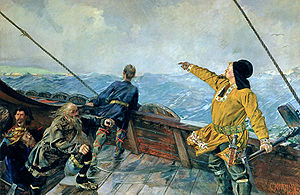 Leif Ericson discovers America. Painting by Christian Krogh, 1893.
Leif Ericson discovers America. Painting by Christian Krogh, 1893.
By the middle of the 11th century, the Norwegian kingdom was firmly established, although there was still only a very rudimentary administrative framework. The establishment of cities gathered pace, and by the end of the 11th century, the three largest cities of modern-day Norway, Oslo, Trondheim (Nidaros) and Bergen (Bjørgvin) were flourishing, as well as Tønsberg, the most important city in Eastern Norway until c. 1300. King Olaf Kyrre (1067–1093) was the first Norwegian king to be literate. The Church gradually developed its organization, and the archdiocese of Nidaros was established in 1152 or 1153. By that time, there were five dioceses in mainland Norway, with bishops in Nidaros, Bjorgvin, Stavanger, Oslo and Hamar. The islands of the North Sea, which had been colonized from Norway, were also part of the archdiocese of Nidaros. Orkney, Shetland and the Faeroe Islands were subject to the Norwegian king. The Hebrides and the Isle of Man were made subject to Norway by King Magnus Barefoot c. 1100. The rulers of these islands held the title of "king" themselves, but recognised the suzerainty of the Norwegian king. The extent to which the Norwegian king was able to exercise his rule over all of these islands was highly variable, and dependent on the individual kings.
According to the succession practices of the time, all sons of the king had the same right to inherit from their father, and this also included illegitimate sons. This led to periods when there were several kings at the same time, at several times three, on one occasion even four. The division of the kingdom does not appear to have been geographical, when there was more than one king, all were kings of the whole country, but they divided the royal income. The unclear succession laws, and the frequent divisions of the kingdom, combined with social and economic conflicts, were some of the main causes of the civil war era, the name given to the period between 1130 and 1240. The civil wars started with the disputed succession after King Sigurd the Crusader, who died in 1130, and flared up at shorter or longer intervals for over a century. In the 1160s, the Church got involved, and made King Magnus Erlingsson the first Norwegian king to be crowned, in 1163 or 1164. The first written succession law was written at this time, stipulating one king, who had to be of legitimate birth. However, this law never came into force, as King Magnus was defeated and killed by Sverre Sigurdsson, who became King Sverre. Sverre was excommunicated by the Church, and the country was placed under an interdict. Although constantly challenged by various pretenders, Sverre fended off his rivals, and when he died in 1202, he was the first King of Norway to have died of natural causes since 1130. By this time, the warring factions had coalesced into two groups: The birchlegs, King Sverre's party, and the bagler, who were supported by the Church, and tried to place descendants of King Magnus Erlingsson on the throne. From 1208 to 1217, the country was divided between these two factions by a peace treaty. In 1217, the kings of both factions died, and both accepted the young King Haakon Haakonsson as king. Haakon defeated the last royal pretender in 1240, thus ending the civil war era.
The extent to which the civil wars adversely affected the general population at the time has been debated by recent historians. What is clear is that the country came out of the civil wars in 1240 as a much more unified and consolidated kingdom than it had been in 1130. The rule of King Haakon and his successors until 1319 has sometimes been called the golden age of the Norwegian medieval kingdom, by later historians. Under King Haakon Haakonsson, a centralised administration was for the first time built up, with a chancellery in Bergen, which became the first capital city of the country. Clear succession laws were put into place, stipulating one single ruler, who had to be of legitimate birth. The Old Norse language, which had first been written with the Latin alphabet in the 12th century, was used in administration, as well as for the composition of original literature, and the translation of foreign literature. Haakon also brought Iceland and Greenland under Norwegian rule, in the early 1260s, at which point the kingdom of Norway reached its largest territorial extent. Haakon died in 1263 while on campaign against Scotland, defending his claim to the overlordship of the Hebrides and the Isle of Man. His successor, King Magnus the Lawmender gave up that claim in the treaty of Perth, but secured Scotland's recognition of Norwegian rule over Orkney and Shetland. King Magnus promulgated the first national law-code for all of Norway in 1274, a rare thing in Europe at that time. During the late 13th century, the Norwegian kings attempted to play the part of a great power in international politics, forging wedding alliances with Castile in 1258, and Scotland in 1281. King Eirik II was one of the many claimants for the throne of Scotland in the "Great Cause", claiming succession from his daughter, Margaret. In 1295, he forged an alliance with France and Scotland against England, whereby Norway undertook to supply the King of France with 300 ships and 50 000 troops. It is clear that Norway could not have the manpower to fulfil the terms of this treaty; however, it was never put to the test.
In 1299, King Haakon V took the throne, and moved the capital of the country to Oslo. Haakon led an active foreign policy, aimed at increasing Norway's influence in Scandinavia[citation needed]. These policies, which included complex dynastic ties between the Nordic royal houses, were to lead Norway into several centuries of unions with her neighbours. At his death, Haakon left no male issue, and the throne went to his daughter's son, the King of Sweden, Magnus Eriksson. The union with Sweden was a personal union, and it was agreed[by whom?] that Magnus' two sons would inherit one kingdom each. King Magnus abdicated, and his son, Haakon, became King of Norway. However, Haakon, who married Margrethe, the daughter of the Danish king, also vied for the throne of Sweden. Haakon and Margrethe's son, Olaf, became King of Denmark in 1376. On his father's death in 1380, Olaf also succeeded to the Norwegian throne, as King Olav IV. With brief exceptions, Norway and Denmark were to be ruled by the same king until 1814.
The Kalmar Union and the union with Denmark
After the Black Death Norway entered into a period of decline. The Royal line died out and the country entered into two unequal unions from 1396 until 1814; this period was called "the 400-year-night" by Henrik Ibsen during the national romantic period as Norwegian national awareness was rediscovered in the 19th century. It can be broken into two main periods:
- The union of all Scandinavia referred to as the Kalmar Union, and
- The Danish Period or Union with Denmark.
The Kalmar Union (1396–1523)
Main article: Kalmar UnionKing Haakon V died without male heirs in 1319. His daughter married a Swedish prince, whose son Magnus Eriksson inherited both kingdoms. Magnus's son Haakon VI and his infant son Olav IV were Norway's last native kings until Harald V ascended to the throne in 1991. Margrethe, the queen mother, who was the oldest daughter of King Valdemar IV of Denmark, succeeded in uniting Norway with Denmark and Sweden in the Kalmar Union (1397–1523), which ended after 180 years when Sweden seceded in 1536. Norway's power was weakened during this period by the loss of a large part of the population during the Black Death pandemic of 1349–1351.
The Union with Denmark (1523–1814)
Main article: Denmark–NorwayThe elite in Norway was so weakened that it was not able to resist the pressures from the Danes. More and more decisions were taken in Copenhagen and the Norwegian Riksråd was eventually disbanded. The Danish crown was represented by a governor styled Statholder, but it was always important for the King to maintain Norway's legal status as a separate hereditary kingdom. The Danish period can be separated into subperiods:
- The Reformation in Norway (1537–1596): Norway's power was further weakened by the dissolution of the independent Norwegian church in the reformation of 1537. Norway became a tributary to Denmark.
- The Northern Wars (1596–1720): A period of virtually continual war and preparation for war, including the Kalmar War (1611–1613), the Thirty Years' War (1618–1648), the Second Northern War (1655–1658), the Gyldenløve War (1675–1679) and culminating in the Great Northern War (1700–1721). In the treaties of Roskilde and Copenhagen, Norway lost Bohuslen, Jemtland and Herjedalen, in addition to Idre and Serna, two smaller communities of Eastern Norway.
- The Period of Peace and Economic Growth (1721–1770): During the 18th century, Norway enjoyed a period of great prosperity and became an increasingly important part of the united kingdoms.
- National Reawakening and Preparation for Independence (1770–1814): This period was built on the strong natural independence of the Norwegian farm culture, combined with awareness of the American Revolution (1775–1783) and the French Revolution (1789–1799), building the natural national assertiveness, and culminating in the constitutional convention of 1814.
Maps of Norway at various dates
Union with Sweden (1814–1905)
Main article: Union between Sweden and Norway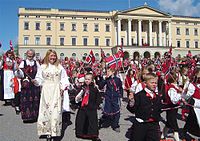 Constitution Day celebration outside the Royal Palace, Oslo.
Constitution Day celebration outside the Royal Palace, Oslo.
In 1814 Denmark–Norway was defeated in the Napoleonic wars and the king was forced to cede Norway to the king of Sweden in the Treaty of Kiel (January 14). The Norwegian dependencies Iceland, Greenland and the Faroe Islands were kept by Denmark. In an attempt to retain control over Norway despite the treaty, the Viceroy and hereditary prince of Denmark–Norway encouraged representatives of various social and political factions to gather at Eidsvoll to declare independence, adopt a constitution and elect hereditary prince Christian Frederik as king. May 17 is still celebrated as the day of the new democratic constitution of independent Norway. Sweden responded later the same year by waging war on Norway. In the peace negotiations, Christian Frederik agreed to relinquish claims to the Norwegian throne and return to Denmark if Sweden would accept the democratic Norwegian constitution and a loose personal union. The Norwegian parliament (Stortinget) then elected the Swedish king as king of Norway on November 4, 1814. When residing in Sweden, the king was represented by a governor-general styled Stattholder, often noble, repeatedly even the Crown Prince (then called Viceroy). The stattholder office, vacant after 1856, was abolished in 1873.
The union was peacefully dissolved in 1905 after several years of political unrest when Sweden recognised Norwegian independence. The parliament offered the throne to Prince Carl of Denmark, who accepted it after a referendum confirmed the monarchy and rejected a republican form of government. On November 18 he ascended the throne under the Norwegian name of Haakon VII.
Independent monarchy (1905–present)
Norway in World War I
Norway remained neutral during World War I, but 829 Norwegian ships were sunk during the war at sea,[2] with the loss of some 2,000 sailors.[3] Despite their neutrality, the Norwegian government went to considerable lengths to accommodate Britain, on account of both British pressure and an anti-German sentiment. These accommodations came in the form of the very large Norwegian merchant fleet, which delivered essential supplies to Britain, which in return supplied Norway with vital coal. This led to Norway occasionally being called The Neutral Ally.
Interwar years
A political tension developed in Norway during the 1930s. The effects of the international economic depression on Norway created a stalemate within the government. This stalemate created a frustation with moderate governments in Norway and allowed extremists on both the left and the right of Norweigan politics to thrive. The right-wing of Norweigan politics was embodied in the career of Vidkun Quisling. The Norwegan parliament consisted of 150 seats. Between 1930 and 1936, six political parties from across the Norweigan political spectrum competed for these seats. During the general election of 1933, the Labor Party received 500,526 votes from the Norweigan public. The Conservative Party received 272,690 votes, the Liberal Party received 220,001 votes, the Farmers Party received 173,534 votes. On the extremes of Norweigan politices, the right wing was represented by Quisling's Nasjonal Samling or the "National Unification Party" which in 1933 received only 27,847 votes and the left wing was represented by the Communist Party of Norway, which in 1933 recieved only 22,000 votes.[4]
Norway in World War II
Main article: Occupation of Norway by Nazi GermanySee also: Norwegian Campaign, Norwegian resistance movement, Quisling regime, and Legal purge in Norway after World War IIAs World War II erupted, Norway insisted on remaining neutral. In a surprise dawn attack on April 9, 1940, Germany launched Operation Weserübung. The German forces attacked Oslo and the major Norwegian ports (Bergen, Trondheim, Kristiansand and Narvik) and quickly gained footholds in those cities and the surrounding areas. The Norwegian Army, manning a fort in the Oslofjord, sank the German cruiser Blücher. This delayed the Nazi German invasion long enough for King Haakon, his government and the parliament to escape the city with much of the treasury, and to resist the invaders. The Norwegian armed forces, together with allied British, French and Polish forces, kept up an organized military resistance for two months, longer than any other country invaded by Germany, except for the Soviet Union. Eventually, on June 7 the Norwegian forces had to surrender and King and government left Norway to form a government in exile in London.
The Norwegian national socialist politician Vidkun Quisling attempted a coup the same day, but was met with such strong resistance from the people that Nazi Germany deposed him within a week and installed a bureaucratic administration in lieu of a government. In September 1940 the German Reichskommissar Josef Terboven formed a cabinet with himself presiding, and with most ministers recruited among members of Quisling's Nazi party, plus some independent collaborators. In 1942 this administration was replaced with a semi-independent puppet government headed by Quisling, who was promoted to "minister president" of the "National government" by the Reichskommissar. Quisling's name has come to mean "traitor" in several languages.
King Haakon and his government fled to Britain on June 7, the same day the allied forces that had retaken Narvik abandoned it and the French forces returned to a quickly disintegrating France. The continued existence of a legitimate Norwegian government gave the exiles considerably more room for action than the French. The worldwide operations of the large Norwegian merchant fleet were a material aid to the Allies.
The Norwegian resistance movement began on a small scale right after the invasion, but gained in strength, especially after the installation of Quisling's puppet government in late 1940 and its attempt to enforce the native brand of fascism, and to enroll labour, teachers and officials in its organizations (for an anecdote of Norwegian civil resistance, see Paper Clip).
The resistance became very active towards the end of the war, closely and continuously supported by the British SOE. Norwegian resistance (generally termed the 'Home Front'), and its military branch (milorg) kept many German divisions tied down in occupation duty, and Norwegian spotters contributed to the destruction of numerous German warships and installations. The Norwegian resistance also smuggled people in and out of Norway during the war (typically to Scotland via the 'Shetland Bus', and to neutral Sweden), and, with the SOE, managed to destroy much of the world's supply of heavy water and cripple the Vemork heavy water plant at Rjukan, thus perhaps preventing Germany from developing an atomic bomb (Operation Gunnerside).
Not all Norwegians sided with the government in exile. 2% of the population became members of Quisling's National Socialist party (Nasjonal Samling – NS). Numerous opportunists joined his movement initially, while Germany seemed to be winning the war. Six thousand young Norwegians joined German Waffen-SS divisions to fight against the Soviet Union on the Eastern Front.
Following the 1941 raid by British Commandos on the minor port of Vaagsoy, Hitler further reinforced Norway, mistakenly thinking that the British might invade northern Norway to put pressure on Sweden and Finland. By the end of the war the German garrison was 372,000 strong (the Norwegian population at the time numbering a little over 3 million). In May 1945, when the milorg was advised they no longer need act covertly, they were found to number some 50,000 members.
During the entire occupation, the German authorities built the so called Festung Norwegen. Innumerable bunkers, pillboxes, air strips and submarine hangars dotted the coast to fend off any invaders. Coupled with the large number of German soldiers in Norway, the Allies (especially the Norwegian government in exile) were worried that the remnants of the Nazi party would flee to Norway and make their last stand there.
The Norwegian merchant ships that were in Allied waters at the time of invasion were requisitioned by the exiled Norwegian Government in London. The Norwegian Shipping and Trade Mission was established in London shortly thereafter, and the name abbreviated to Nortraship, following a suggestion from the British Postal Services. The main duties were those of war transports, supply services etc. including the supply of food, ammunition and reinforcements to the front lines, besides evacuating the wounded. Nortraship had 1,081 ships with 33,000 sailors. 570 ships were lost (these numbers vary according to source), along with 3,734 sailors.
By the end of the war, Norwegian naval vessels were also fighting alongside the British. Norway was counted among the victors in World War II and was a founding member of the United Nations. The first UN Secretary General, Trygve Lie, was a Norwegian.
After the liberation, active members of the National Socialist party and those who had collaborated with the enemy were prosecuted and sentenced. Twenty-five Norwegians, including Quisling, were executed for treason and/or war crimes, and 12 Germans were executed for war crimes.
Post-war
Main articles: Foreign relations of Norway, Military of Norway, and Norway and the European UnionA side effect of the large German garrison was the birth of up to 12,000 children born to Norwegian women and German soldiers. Most of these women suffered recriminations after the war, as did their children, who were called tyskerbarna ("German children") or "Nazi children". Many children were sent to homes where they had to suffer physical and sexual abuse, some have been used as test subjects for medical experiments.[5][6]
In 1949 Norway became a member of NATO.
The discovery of oil and gas in adjacent waters in the late 1960s boosted Norway's economic fortunes.
The current focus is on containing spending on the extensive welfare system and planning for the time when petroleum reserves are depleted. In referendums held in 1972 and on November 28, 1994, Norway rejected joining the European Union, though it chose to remain associated with it through being part of the wider European Economic Area.
Norway has advanced in its standard of living beyond many of its European counterparts, in large part to its affluent economy. As a result, for the last several years the United Nations has ranked Norway as having the highest standard of living in the world. This ranking compares nations' level of education and income, combined with expected length of life.
Norway also ranked 2nd in a study conducted by World Economic Forum on the gender gap in 58 nations based on measuring the level of equality with men in five areas: Economic participation, economic opportunity, political empowerment, educational attainment, and health and well-being.[7][8]
21st century
Since the year 2000, Norway has focused on culture. A number of museums have been built and now the new Munch museum and the Historic Museum is the government's current focus. The construction of the new financial district is a new mass-scale project in Oslo. As the biggest building project in Scandinavian history the government plans to renovate Bjørvika and eastern Oslo. The Oslo Opera House received two architectural awards in 2008 and 2009. The new "port of Oslo", or Eufemias Street (codename: "Barcode") is being built, before the new Oslo Central Station will be built in 2014. Oslo has established a large group of telecom and software companies. Some of the probably largest ones are Telenor, Opera Software, Statnett, Netcom and Ementor. A new IT "city" has been built at Fornebu, Bærum near Oslo. Until 2008, Tandberg's headquarer was located at Lysaker, outside Fornebu The area is currently housing the headquarters of Telenor, Microsoft Norway and Oracle Norway.
A three-party minority coalition of the Centre, Christian Democratic, and Liberal parties, headed by Christian Democrat Prime Minister Kjell Magne Bondevik, moved into office in October 1997. That government fell in March 2000, and Jens Stoltenberg took over the government with a cabinet from the Norwegian Labour Party. In 2001, Bondevik once again became Prime Minister in 2001, this time as head of a minority coalition of the Conservatives, Christian Democrats and Liberals. Since 2005, Jens Stoltenberg has been leading a red-green coalition, consisting of Norwegian Labour Party, Socialist Left Party and Center Party.
Norway participated in sending troops to serve in Afghanistan as part of the NATO force that responded to the Taliban government’s support of al-Qaeda. Norway also contributed warplanes to the NATO mission to Libya in 2011.
On 22 July 2011, terror attacks took place, including bombings in the government offices in Oslo and a shooting in Utøya island in Buskerud, where the Workers' Youth League (the youth organization affiliated with the Labour Party) held the yearly camp. The bomb explotion was centred a short distance from the building complex, and seven persons were killed and others injured. In the shooting 69 persons were killed, many of which were less than 18 years old. Soon after, the attacker Anders Behring Breivik was captured. This was the deadliest incident in Norway since World War II.
See also
Notes
- ^ Today, only Iceland, Norway, Switzerland, and Liechtenstein remain members of EFTA (of which only Norway and Switzerland are founding members). The Stockholm Convention was subsequently replaced by the Vaduz Convention. This Convention provides for the liberalisation of trade among the member states.
- ^ "The Neutrals". Time Magazine: p. 2. 14 August 1939. http://www.time.com/time/magazine/article/0,9171,761839-2,00.html. Retrieved 24 January 2009.
- ^ Dagre, Tor. "Norway after 1905". Ministry of Foreign Affairs (Norway). http://www.norway.org/history/after1814/post1905/post1905.htm. Retrieved 2009-02-08.[dead link]
- ^ Ralph Hewins, Quisling: Prophet Without Honor (John Day Publishing Co.: New York, 1966) p. 129.
- ^ Oustad, Hans Ola (14 November 2005). "Tormented 'war children' take Norway to court". Aftenposten. http://www.aftenposten.no/english/local/article1156044.ece. Retrieved 24 January 2009.
- ^ Rosenberg, Steve (8 March 2007). "Norway sued by children of Nazis". BBC News. http://news.bbc.co.uk/2/hi/europe/6429565.stm. Retrieved 24 January 2009.
- ^ "women_gap_ok5" (PDF). http://www.weforum.org/pdf/Global_Competitiveness_Reports/Reports/gender_gap.pdf. Retrieved 2010-04-23.
- ^ Norway dot com (2004-07-23). "Norway travel, business, cruises and energy resources". Norway.com. http://www.norway.com/publish.asp?id=118. Retrieved 2010-04-23.
Sources and External links
- History of Norway - World History Database
- Norway — Article from the 1907 Catholic Encyclopedia which details much about Norway including history.
- History of Norway — Overview to Norwegian history.
- History of Norway: Primary Documents
- WorldStatesmen — Norway
- Historical Atlas of Norway
- Det rike landet
- V.Malstøm: Norway before the Vikings
- Map showing regions of Medieval Norway
Bibliography
- Karsten Alnæs: A history of Norway in words and pictures (illustrated book in coffee table format) Gyldendal 2001 ISBN 82-05-27500-9
- Rolf Danielsen, Ståle Dyrvik, Tore Grønlie, Knut Helle, Edgar Hovland: Norway: A History from the Vikings to Our Own Times (The most recent single volume academic history of Norway in English) Scandinavian University Press 1995 ISBN 9788200218036
- Fritz Hodne An economic history of Norway : 1815-1970 (English language edition superseded by two more recent Norwegian language books) Tapir 1975 ISBN 82-519-0134-0
- William H. Hubbard ed. Making a historical culture : historiography in Norway Scandinavian University Press 1995 ISBN 82-00-22699-9
- Olav Riste: Norway's Foreign Relations 2nd ed 2005 ISBN 9788215007434
- Francis Sejersted. The Age of Social Democracy: Norway and Sweden in the Twentieth Century (Princeton University Press; 2011) 543 pages; Traces the history of the Scandinavian social model as it developed after the separation of Norway and Sweden in 1905.
- Øivind Stenersen, Ivar Libæk: The history of Norway: from the Ice age to today ISBN 82-8071-041-8
History of Europe Prehistoric Europe Classical Antiquity Classical Greece · Roman Republic · Hellenistic period · Roman Empire · Late Antiquity · Early Christianity · Crisis of the 3rd century · Fall of the Roman EmpireMiddle Ages Early Middle Ages · Migration Period · Byzantine Empire · Christianization · Kievan Rus · High Middle Ages · Holy Roman Empire · Crusades · Feudalism · Late Middle Ages · Hundred Years' War · RenaissanceEarly Modern Europe Reformation · Age of Discovery · Baroque · Thirty Years' War · Absolutism · Ottoman Empire · Portuguese Empire · Spanish Empire · Early modern France · Polish–Lithuanian Commonwealth · Swedish Empire · Dutch Republic · British Empire · Habsburg Empire · Russian EmpireModern history See also History of Europe by country Sovereign
states- Albania
- Andorra
- Armenia
- Austria
- Azerbaijan
- Belarus
- Belgium
- Bosnia and Herzegovina
- Bulgaria
- Croatia
- Cyprus
- Czech Republic
- Denmark
- Estonia
- Finland
- France
- Georgia
- Germany
- Greece
- Hungary
- Iceland
- Ireland
- Italy
- Kazakhstan
- Latvia
- Liechtenstein
- Lithuania
- Luxembourg
- Macedonia
- Malta
- Moldova
- Monaco
- Montenegro
- Netherlands
- Norway
- Poland
- Portugal
- Romania
- Russia
- San Marino
- Serbia
- Slovakia
- Slovenia
- Spain
- Sweden
- Switzerland
- Turkey
- Ukraine
- United Kingdom
- (England
- Northern Ireland
- Scotland
- Wales)
- Vatican City
States with limited
recognition- Abkhazia
- Kosovo
- Nagorno-Karabakh
- Northern Cyprus
- South Ossetia
- Transnistria
Dependencies
and other territories- Åland
- Faroe Islands
- Gibraltar
- Guernsey
- Jan Mayen
- Jersey
- Isle of Man
- Svalbard
Other entities - European Union
- Sovereign Military Order of Malta
 Norway topics
Norway topicsHistory Geography Law Politics Constitution · Counties · Elections · European Union relations · Foreign relations · Government · Monarchy · Municipalities · Political parties · Prime Minister (List) · Romantic nationalism · Sámi Parliament · ParliamentEconomy Norwegian krone · National Bank · Oslo Stock Exchange · Education · Energy · Media · Tourism · Transport · Companies · WhalingMilitary Symbols Demographics Administrative divisions · Cities · Postal codes · Languages · Religion · Immigration · Norwegians · List of NorwegiansCulture Architecture · Art · Cinema (Actors) · Music (Composers) · Cuisine · Norwegian language · Literature (Writers · Poets) · Bunad · Jul · Constitution Day · Media · Football · Rugby union · Public holidaysCategories:
Wikimedia Foundation. 2010.

